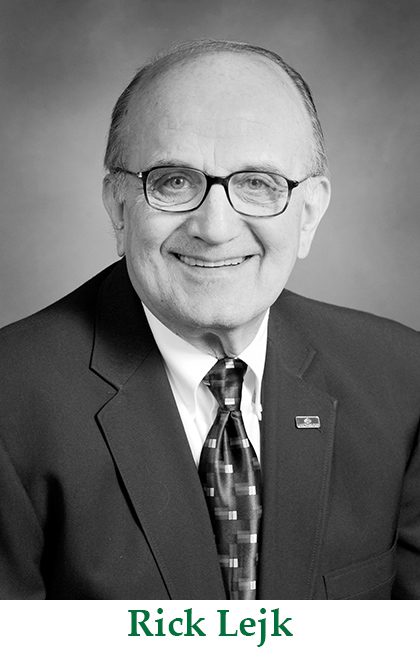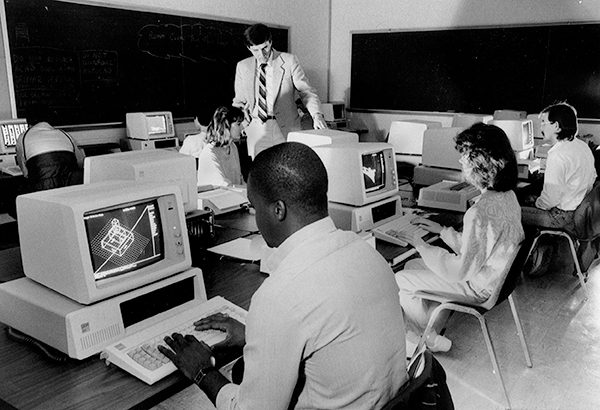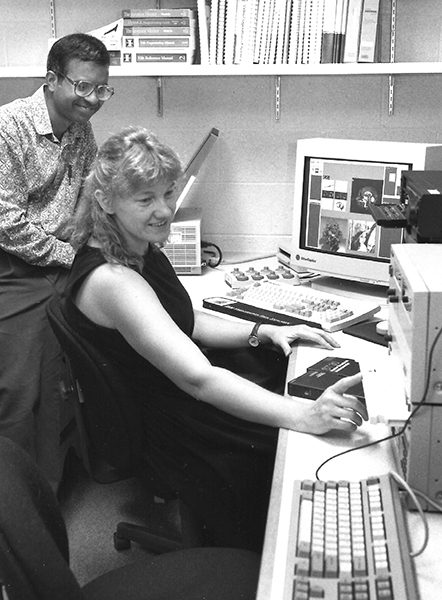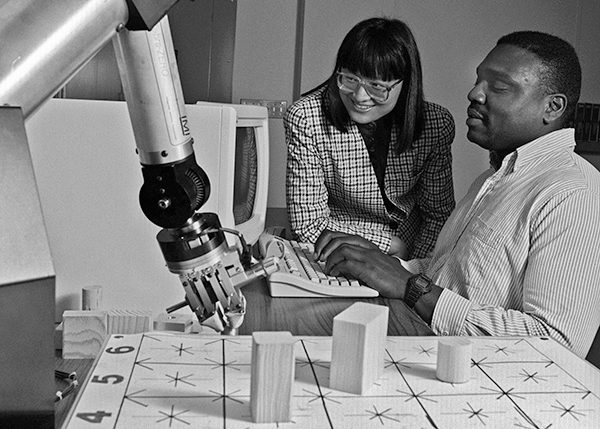Computer Science
Faculty from the Electrical Engineering Department and Math Department came together in 1985 to form UNC Charlotte’s Computer Science Department. The original home of the new department was the Lee College of Engineering, where it stayed until growing large enough to become the School of Information Technology in 1998, and then the College of Information Technology in 2000, which was renamed the College of Computing and Informatics in 2006.

Rick Lejk started as a faculty member in the UNC Charlotte Math Department in 1983 and would go on to a long career in every iteration of computer science. Math was a department of the College of Arts and Science at the time, and offered computer science as an option.
“We were looking forward to staying in arts and science,”Lejk said. “We wanted to become our own major. There was a study that found we should become our own department, but that we should be in engineering. We revolted. We said ‘hell no.’ There was a meeting about the change and one of our lectures came in with a knife strapped to her back and she said ‘We’ have been stabbed in the back.’ Bob Snyder came in in his typical golf outfit, pink shirt, pink pants, and sat at one end of the table. The rest of us sat at the other end. I don’t think he said a word.”
Lejk was originally an engineer by education, having graduated from Georgia Tech with his bachelor’s in industrial engineering in 1955. He then joined the Air Force, where he completed a master’s degree in computer science at the University of Michigan in 1960, and then a Ph.D. in statistics from Texas A&M in 1967. After 27 years in the Air Force, he retired and came to UNC Charlotte.
“Only reason we came here,” Lejk said, “was I didn’t want to go north because it was too cold, and my wife didn’t want to go west because of earth quakes. My daughter was living here at the time and we saw ‘best places to live’ list that rated Charlotte high, so we came here. I looked for a part-time job and got hired in the math department as a lecturer.”

The math department had a number of people teaching classes and doing research in computers, including Lejk. The effort on the Math Department side was being led by Joe Shell. A few electrical engineering faculty members were collaborating with them, including Mike Allen. The college of engineering moved two electrical engineering positions to the new Computer Science Department. Along with about five faculty members from math, they comprised the original UNC Charlotte Computer Science Department.
“We were supposed to be a forefront of computer science,” Lejk said, “but at that time there was always friction between EE and CS. It never subsided, never never. We swept it under the rug at times, ignored it at times, but it never went away. There was always that tension there.”
The Computer Science Department offered a bachelor’s of science program and a bachelor’s of arts program in computer science. A master’s program followed in later years.
“The BA came with us from math,” Lejk said, “and it rankled some people. They said it was a sissy degree, just a watered down BS. Eventually we added more substance to it and it did change.”
There were some misunderstandings between the engineers and the computer group when it came to how to define some of the new courses and programs.
“Bob Snyder always seemed to have a problem with computer science terms,” Lejk said. “Like when we talked about software engineering, he didn’t think the word ‘engineering’ belonged in the course title at first. We had to convince him that it was a computer application of an engineering principle, then we finally got approval.”
Snyder was very supportive of computer science, and did all he could to fund and grow the program, including pushing its faculty to greater levels of research.
“He tried to instill in us a sense of research,” Lejk said. “At the time, the research we had going on was all theoretical and all very limited. He was the little spark trying to start the fire of research in computer science.”

The computer science program was extremely successful in its bachelor’s programs, at one time having close to 1,000 students during the dot-com boom, which made it the largest program in engineering.
“There was the dot-com explosion and then the failure came,” Lejk said. “We lost over half our majors that quick.”
Computer science was also successful in providing its students with real-world learning opportunities, many of them through on-campus jobs and senior projects. “We were one of the most known majors at the time, because we had students working in department and in administration all over campus,” Lejk said. “Computers were just getting popular and people were looking for cheap labor. In some cases they just wanted our students to do data entry and we said ‘no, you can hire a clerk for that.’ We made sure they our students got a real learning experience.”
In 1998, UNC Charlotte formed the School of Information Technology and named Joanna Baker director. The school ran the Master’s of Computer Science and Ph.D. in Information Technology programs. In 2000, the School of IT became the College of Information Technology and left the college of engineering.
The first dean of the new College of IT was Mirsad Hadzikadic, who had at one time been chair of computer science. “Mirsad was the guiding force in setting up the college and everything that went after it,” Lejk said.
Lejk saw huge advancement in his field and in the computer science academic programs at UNC Charlotte during his career. In terms of facilities, the computer group went from the Kennedy Building to the Cameron Center to Woodward Hall. In terms of technological advancement, they went from giant computers programed with punch cards to hand-held devices.
“I always tell the kids when I go into class, I’m only person in the room who has ever slept inside a computer,” Lejk said. “There was one computer we used for tracking the missiles coming in on ships during crisis with Cuba that was huge. It was in the only Air Force building on the base that was air conditioned. We used to do periodic maintenance by walking through the computer and making sure the vacuum tubes were burning. Part of the interior was padded and was so big you could lay down and take a nap. And it was air conditioned. So, I’ve slept inside a computer.”

